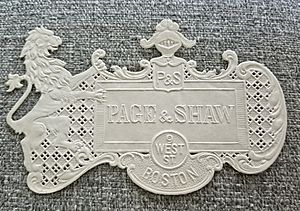- This page was last modified on 17 October 2025, at 10:18. Suggest an edit.
Page & Shaw facts for kids
Page & Shaw was a very famous candy company in the United States. It made delicious chocolates and other sweets for many years, from 1888 until around 1960.
The company started as a small candy shop in Boston, Massachusetts. This was at 9 West Street. In 1911, Page & Shaw opened a much bigger factory. This new factory was in Cambridge, Massachusetts, on Ames Street. They also had stores in other countries. These included England, France, and Canada.
In 1918, the government had rules about how much sugar companies could keep. Page & Shaw kept more sugar than allowed. Because of this, their factory and five stores had to close for one week. This was ordered by the Federal Food Board.
Around 1920, a lawyer named Otis Emerson Dunham took control of the company. He wanted Page & Shaw to grow much bigger. He started a big plan to expand the business. By 1924, the company was selling a lot of chocolate. They sold about 2,200,000 pounds of chocolate every year!
At its best, Page & Shaw had 35 shops. They also had candy factories in many big cities. These cities included Cambridge, New York City, Philadelphia, Boston, Chicago, San Francisco, Los Angeles, Montreal, and London. The Cambridge factory alone made over 6,000,000 pounds of chocolate candies each year. That's a lot of candy!
After the stock market crash in 1929, the company's sales dropped a lot. To try and help, they started giving away one share of company stock. You would get a share if you bought $2 worth of candy.
However, there were problems with how the company's money and shares were handled. In 1930, the company faced financial difficulties. Page & Shaw went bankrupt that same year. Another company, Daggett Co., bought Page & Shaw in 1931. Later, in 1960, Daggett Co. was bought by Necco. Around that time, Page & Shaw chocolates were no longer made.
Today, the MIT's Wiesner Building stands where Page & Shaw's old factory used to be. This is on Ames Street in Cambridge.
See also
References
- History of Massachusetts Industries, by Orra L. Stone, 1930, pages 829–831.
- The Sweet History of Cambridge, Cambridge Public Library, Cambridge, Massachusetts.
- Page & Shaw, Incorporated, Scripophily article.

